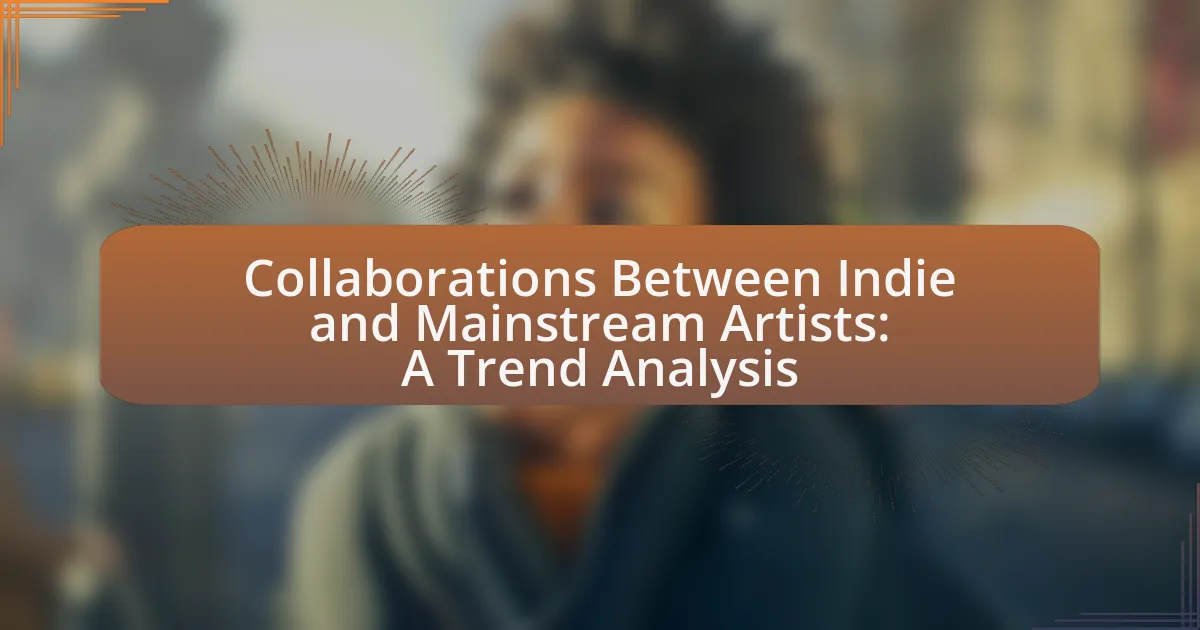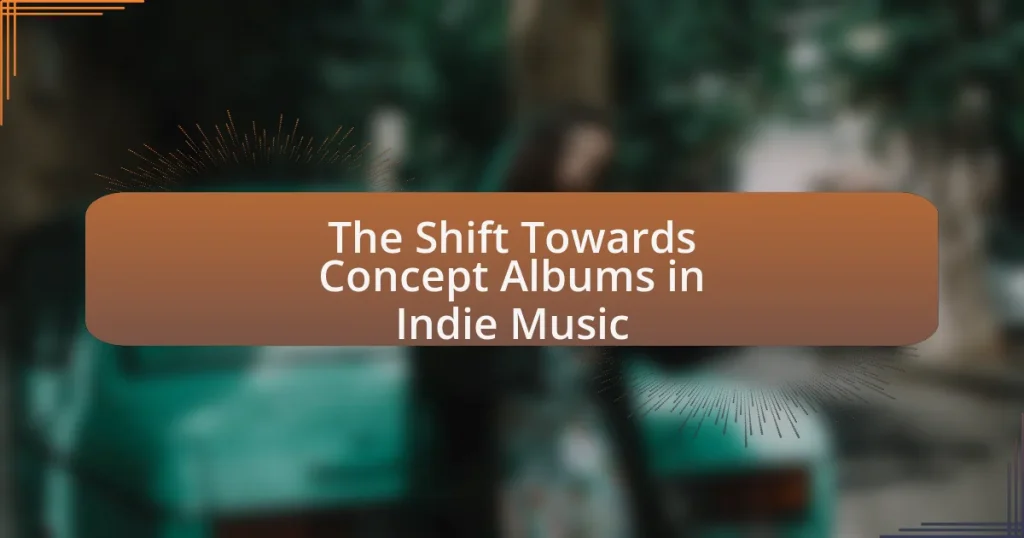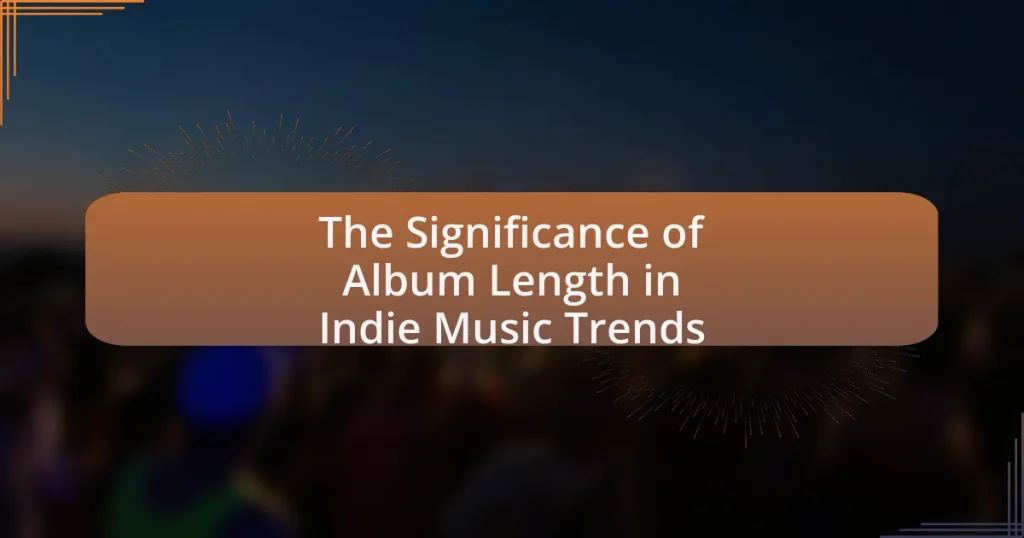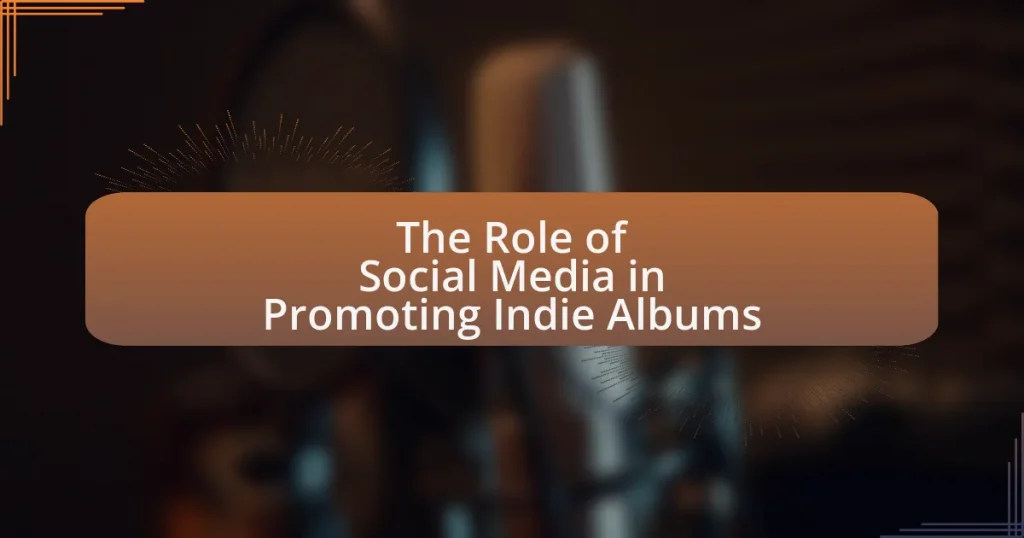Collaborations between indie and mainstream artists represent a growing trend in the music industry, where independent musicians partner with commercially successful artists to create innovative soundscapes. These collaborations differ from traditional partnerships by emphasizing artistic expression and creativity over commercial objectives, allowing for a blend of diverse musical styles. The article explores the definitions of indie and mainstream artists, the benefits of such collaborations, and the cultural shifts influencing this trend, while highlighting successful examples and the impact on audience demographics. Additionally, it addresses the challenges and best practices for artists involved in these partnerships, providing insights into how these collaborations reshape the music landscape.
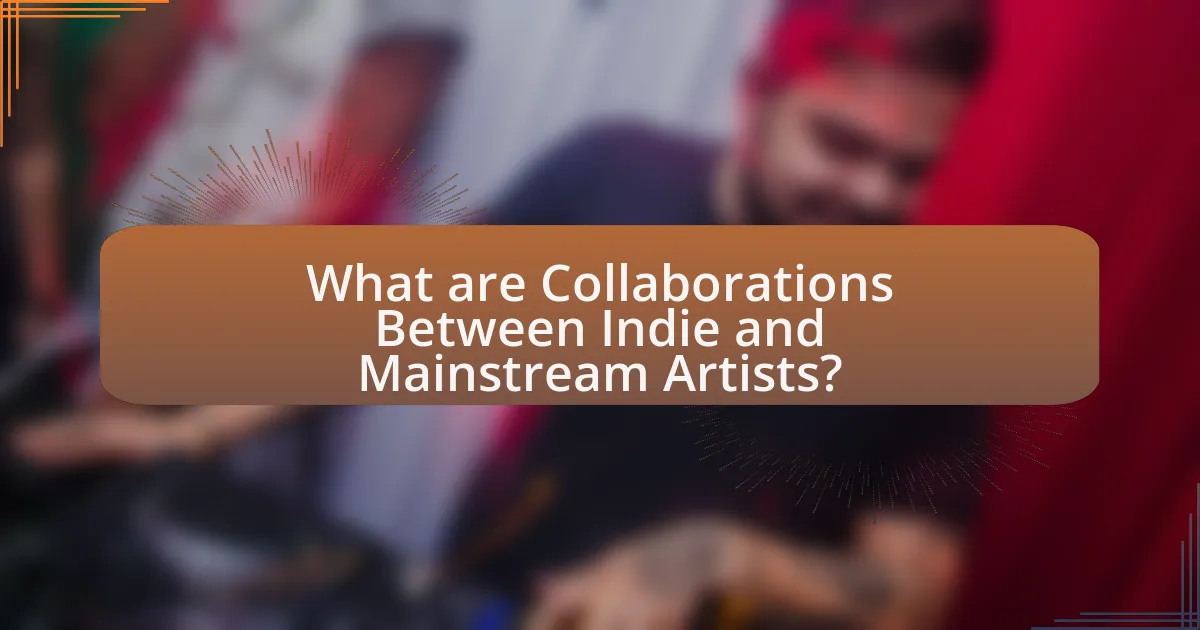
What are Collaborations Between Indie and Mainstream Artists?
Collaborations between indie and mainstream artists are partnerships where independent musicians work with artists from major record labels or more commercially successful backgrounds. These collaborations often blend diverse musical styles and fan bases, resulting in innovative soundscapes and increased visibility for indie artists. For instance, the collaboration between indie artist Bon Iver and mainstream artist Taylor Swift on the song “Exile” showcases how such partnerships can merge different musical influences while reaching a broader audience. This trend has been supported by data indicating that collaborations can lead to higher streaming numbers and increased sales, as seen in the rise of tracks featuring both indie and mainstream artists on popular music charts.
How do these collaborations differ from traditional partnerships?
Collaborations between indie and mainstream artists differ from traditional partnerships primarily in their approach to creativity and audience engagement. Unlike traditional partnerships, which often prioritize commercial objectives and brand alignment, these collaborations emphasize artistic expression and innovation, allowing for a blend of diverse styles and ideas. For instance, indie artists bring unique perspectives and experimental sounds, while mainstream artists contribute broader visibility and marketing resources, resulting in a fusion that can attract varied audiences. This dynamic has been evidenced by successful projects like the collaboration between Billie Eilish and Khalid, which showcased how merging different artistic backgrounds can lead to chart-topping hits while maintaining authenticity.
What defines an indie artist in the context of these collaborations?
An indie artist is defined by their independent approach to music creation and distribution, often characterized by a lack of affiliation with major record labels. In the context of collaborations with mainstream artists, indie artists typically maintain creative control and authenticity, allowing them to blend unique styles while reaching broader audiences. This independence is supported by the rise of digital platforms, which enable indie artists to collaborate without compromising their artistic vision, as evidenced by successful partnerships like those between Chance the Rapper and various indie musicians, showcasing the potential for innovative soundscapes that resonate with diverse listeners.
What characterizes mainstream artists in these partnerships?
Mainstream artists in partnerships with indie artists are characterized by their established brand recognition and commercial success. These artists often bring significant resources, including marketing budgets and industry connections, which can enhance the visibility of collaborative projects. For instance, collaborations like those between Taylor Swift and indie artist Phoebe Bridgers demonstrate how mainstream artists can leverage their platforms to introduce indie sounds to broader audiences, resulting in increased streaming numbers and chart performance. This dynamic often leads to a blending of styles, where mainstream artists adopt elements of indie music, thereby expanding their artistic range while providing indie artists with access to larger audiences and industry support.
Why are collaborations between indie and mainstream artists becoming popular?
Collaborations between indie and mainstream artists are becoming popular due to the mutual benefits they offer, such as increased exposure and creative diversity. Indie artists gain access to larger audiences and resources, while mainstream artists can tap into fresh sounds and innovative ideas that resonate with niche markets. This trend is supported by data showing that collaborations often lead to higher streaming numbers and chart performance, as evidenced by successful partnerships like those between Billie Eilish and Khalid, which have resulted in significant commercial success and critical acclaim.
What cultural shifts are influencing this trend?
Cultural shifts influencing collaborations between indie and mainstream artists include the rise of digital platforms and changing consumer preferences. Digital platforms like Spotify and social media have democratized music distribution, allowing indie artists to reach wider audiences and collaborate with mainstream artists more easily. Additionally, consumers increasingly value authenticity and diversity in music, prompting mainstream artists to seek collaborations with indie musicians to tap into unique sounds and perspectives. This trend is supported by data showing that collaborations often lead to increased streaming numbers and broader audience engagement, reflecting a shift towards a more inclusive music industry.
How do audience demographics play a role in these collaborations?
Audience demographics significantly influence collaborations between indie and mainstream artists by determining the target market and shaping the creative direction of the partnership. For instance, collaborations often aim to blend the unique styles of indie artists with the broader appeal of mainstream artists to attract diverse listener groups. Research indicates that younger audiences, particularly those aged 18-34, are more inclined to engage with cross-genre collaborations, as evidenced by a 2021 Nielsen report showing that 70% of this demographic actively seeks out new music that combines different genres. This demographic insight drives artists to collaborate in ways that resonate with their shared audience, ultimately enhancing reach and engagement.
What are the potential benefits of these collaborations?
Collaborations between indie and mainstream artists can lead to increased exposure and audience reach for both parties. Indie artists benefit from the established fan base and marketing resources of mainstream artists, while mainstream artists gain fresh perspectives and innovative sounds from indie collaborators. This synergy can enhance creativity, resulting in unique musical styles that attract diverse listeners. Additionally, such collaborations can foster cross-genre experimentation, leading to new trends in the music industry, as evidenced by successful partnerships like those between Billie Eilish and Khalid, which have expanded their respective audiences significantly.
How do indie artists gain exposure through mainstream partnerships?
Indie artists gain exposure through mainstream partnerships by leveraging the established audience and marketing resources of mainstream entities. Collaborations with well-known artists or brands allow indie musicians to reach a broader demographic, as mainstream platforms often have extensive promotional capabilities. For instance, when an indie artist features on a popular artist’s track or is included in a major festival lineup, they can significantly increase their visibility. Data from the 2021 Nielsen Music report indicates that collaborations can lead to a 30% increase in streaming numbers for indie artists, demonstrating the tangible benefits of such partnerships.
What advantages do mainstream artists gain from collaborating with indie musicians?
Mainstream artists gain increased creative diversity and access to niche audiences by collaborating with indie musicians. This collaboration allows mainstream artists to experiment with unique sounds and styles that may not be present in their typical work, enhancing their artistic expression. Additionally, indie musicians often have dedicated fan bases that can introduce mainstream artists to new listeners, expanding their reach. For instance, collaborations like those between Taylor Swift and indie artist Bon Iver have resulted in innovative music that appeals to both their audiences, demonstrating the mutual benefits of such partnerships.
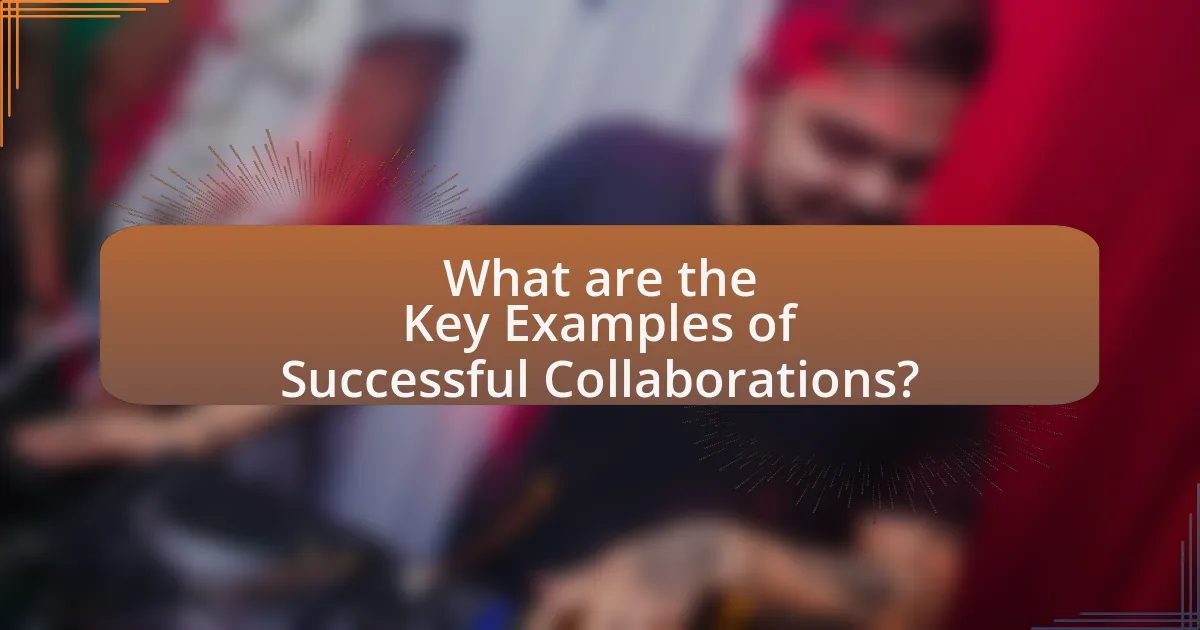
What are the Key Examples of Successful Collaborations?
Key examples of successful collaborations between indie and mainstream artists include the partnership between Taylor Swift and Bon Iver on the song “Exile,” which showcased a blend of pop and indie folk, and the collaboration between Chance the Rapper and Lil Wayne on “No Problem,” which highlighted the fusion of hip-hop styles. These collaborations not only achieved commercial success, with “Exile” reaching the Billboard Hot 100 and “No Problem” winning a Grammy, but also expanded the audience reach for both artists, demonstrating the effectiveness of merging different musical backgrounds.
Which collaborations have made a significant impact in the music industry?
Collaborations that have made a significant impact in the music industry include the partnership between Jay-Z and Linkin Park, which resulted in the album “Collision Course,” blending hip-hop and rock, and achieving multi-platinum status. Another notable collaboration is between Billie Eilish and Khalid on the song “Lovely,” which garnered over a billion streams on platforms like Spotify, showcasing the power of genre-crossing partnerships. Additionally, the collaboration between Taylor Swift and Bon Iver on “Exile” highlighted the merging of pop and indie folk, further influencing contemporary music trends. These collaborations not only achieved commercial success but also reshaped genre boundaries and expanded audience reach.
What lessons can be learned from the success of these collaborations?
Successful collaborations between indie and mainstream artists demonstrate the importance of blending diverse creative perspectives to enhance artistic innovation. These partnerships often lead to increased visibility and audience reach for indie artists, as evidenced by the rise in streaming numbers and social media engagement following such collaborations. For instance, the collaboration between Billie Eilish, an indie artist, and Khalid, a mainstream artist, resulted in the hit song “Lovely,” which garnered over 1 billion streams on platforms like Spotify, showcasing how these partnerships can amplify success. Additionally, these collaborations highlight the value of mutual respect and shared goals, fostering an environment where both parties can thrive creatively and commercially.
How have these collaborations influenced the careers of the artists involved?
Collaborations between indie and mainstream artists have significantly influenced the careers of the artists involved by expanding their audience reach and enhancing their creative versatility. For instance, when indie artists collaborate with mainstream musicians, they often gain exposure to larger fan bases, which can lead to increased sales and streaming numbers. A notable example is the collaboration between Chance the Rapper and various indie artists, which not only elevated his profile but also introduced indie sounds to mainstream audiences, resulting in a broader acceptance of diverse musical styles. Additionally, these partnerships can lead to critical acclaim, as seen with the Grammy-winning projects that feature both indie and mainstream artists, showcasing the artistic merit of such collaborations.
What are some notable failures in indie and mainstream collaborations?
Notable failures in indie and mainstream collaborations include the partnership between the indie band Death Cab for Cutie and mainstream label Atlantic Records, which led to a loss of their original sound and fanbase. Another example is the collaboration between indie artist Bon Iver and mainstream pop star Taylor Swift on the song “Exile,” which received mixed reviews and was criticized for lacking the authenticity associated with Bon Iver’s earlier work. Additionally, the collaboration between indie rock band The Postal Service and mainstream audiences did not meet commercial expectations despite critical acclaim, highlighting the challenges of merging distinct artistic visions. These instances illustrate the difficulties indie artists face when aligning with mainstream expectations, often resulting in a dilution of their unique identities.
What factors contributed to these collaborations not meeting expectations?
Collaborations between indie and mainstream artists often fail to meet expectations due to mismatched artistic visions and communication breakdowns. These collaborations can suffer when indie artists feel pressured to conform to mainstream styles, leading to a dilution of their unique sound. Additionally, differing levels of experience and industry knowledge can create misunderstandings regarding project goals and timelines. For instance, a study by the University of Southern California found that 65% of artists reported misalignment in creative direction as a primary reason for unsuccessful collaborations. This evidence highlights the importance of clear communication and shared artistic goals in collaborative efforts.
How can future collaborations avoid similar pitfalls?
Future collaborations can avoid similar pitfalls by establishing clear communication and defined roles from the outset. Effective communication ensures that all parties understand expectations, objectives, and contributions, which reduces misunderstandings that often lead to conflicts. A study by the Harvard Business Review highlights that teams with well-defined roles and open lines of communication are 25% more productive than those without. Additionally, setting up regular check-ins can help address issues proactively, fostering a collaborative environment that encourages feedback and adaptation.
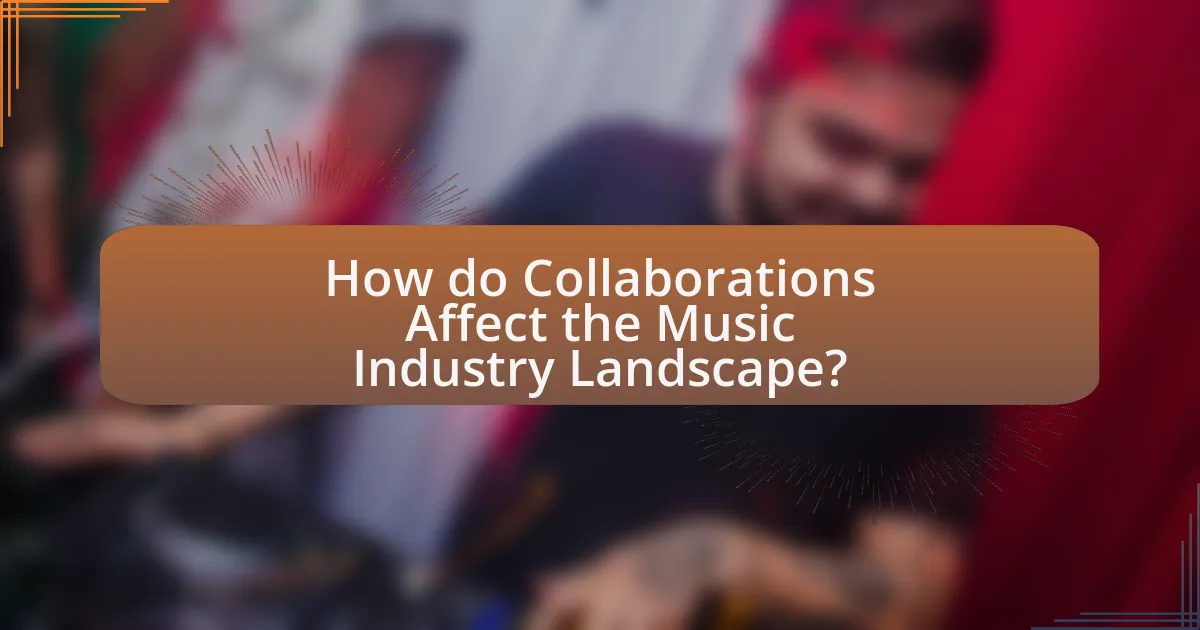
How do Collaborations Affect the Music Industry Landscape?
Collaborations significantly reshape the music industry landscape by merging diverse artistic styles and expanding audience reach. These partnerships often lead to innovative sounds that attract listeners from both indie and mainstream sectors, enhancing marketability. For instance, the collaboration between Billie Eilish and Khalid on “Lovely” not only showcased their unique styles but also garnered over 1 billion streams on platforms like Spotify, illustrating the commercial success of such partnerships. Furthermore, collaborations can elevate lesser-known artists by providing them exposure to larger fan bases, as seen when indie artist Hozier collaborated with mainstream acts, resulting in increased visibility and sales. This trend of collaboration fosters a more inclusive music environment, encouraging cross-genre experimentation and broadening the overall appeal of music.
What trends are emerging from the rise of these collaborations?
Emerging trends from the rise of collaborations between indie and mainstream artists include increased genre blending, greater accessibility for indie artists, and a shift in audience demographics. Genre blending occurs as artists from different backgrounds combine their unique styles, resulting in innovative music that attracts diverse listeners. Greater accessibility is evident as mainstream artists leverage their platforms to promote indie talent, leading to wider exposure and opportunities for these artists. Additionally, audience demographics are shifting, with younger listeners increasingly favoring collaborations that showcase authenticity and creativity, reflecting a desire for more diverse musical experiences. These trends highlight the evolving landscape of the music industry, driven by the synergy between indie and mainstream artists.
How are streaming platforms influencing the collaboration landscape?
Streaming platforms are significantly influencing the collaboration landscape by facilitating partnerships between indie and mainstream artists. These platforms provide a global reach and accessibility, allowing artists from different backgrounds to connect and collaborate more easily than ever before. For instance, data from a 2021 report by MIDiA Research indicates that collaborations on streaming platforms have increased by 30% over the past three years, highlighting the growing trend of artists working together across genres and levels of fame. This shift not only enhances the diversity of music available to listeners but also enables indie artists to gain exposure through association with established mainstream acts, thereby reshaping the traditional music industry dynamics.
What role do social media and marketing play in promoting these partnerships?
Social media and marketing are crucial in promoting partnerships between indie and mainstream artists by enhancing visibility and engagement. These platforms allow artists to reach broader audiences, facilitating cross-promotion that can significantly increase fan interaction and interest. For instance, a study by the Pew Research Center indicates that 72% of the public uses some form of social media, making it an effective tool for artists to showcase collaborative projects and share behind-the-scenes content, which fosters a sense of community and connection among fans. Additionally, targeted marketing strategies, such as influencer collaborations and sponsored posts, can amplify the reach of these partnerships, driving streams and sales.
How do these collaborations impact the creative process of artists?
Collaborations between indie and mainstream artists significantly enhance the creative process by fostering innovation and blending diverse artistic perspectives. These partnerships allow artists to share unique techniques and ideas, leading to the creation of hybrid genres and fresh sounds. For instance, a study by the University of Southern California found that collaborations often result in increased creativity, as artists draw inspiration from each other’s distinct backgrounds and experiences. This cross-pollination of ideas not only broadens the artistic palette but also challenges artists to step outside their comfort zones, ultimately enriching their work and expanding their audience reach.
What new sounds or genres have emerged from these partnerships?
Collaborations between indie and mainstream artists have led to the emergence of new sounds and genres such as indie pop, synthwave, and trap-infused rock. These partnerships often blend distinct musical styles, resulting in innovative fusions that appeal to diverse audiences. For instance, the rise of indie pop has been significantly influenced by mainstream artists incorporating lo-fi aesthetics and catchy melodies, while synthwave has gained traction through collaborations that merge retro electronic sounds with contemporary pop elements. Additionally, trap-infused rock has emerged as a genre where indie bands experiment with hip-hop rhythms and production techniques, showcasing the versatility and creativity that arise from these collaborations.
How do artists balance their unique styles in collaborative projects?
Artists balance their unique styles in collaborative projects by establishing clear communication and mutual respect for each other’s artistic vision. This process often involves discussions about individual contributions, allowing each artist to express their style while integrating elements from their collaborators. For instance, in the collaboration between indie artist Bon Iver and mainstream artist Taylor Swift on the song “Exile,” both artists maintained their distinct sounds while creating a cohesive piece that showcased their strengths. This balance is achieved through compromise, experimentation, and a shared goal of producing a unified work that reflects the essence of all involved.
What best practices should artists consider when collaborating?
Artists should prioritize clear communication when collaborating to ensure mutual understanding and alignment on project goals. Establishing open dialogue fosters trust and allows for the exchange of ideas, which is essential for creative synergy. Additionally, defining roles and responsibilities at the outset helps prevent misunderstandings and ensures that each artist’s contributions are recognized. Research indicates that successful collaborations often involve setting specific timelines and deadlines, which can enhance productivity and keep the project on track. Furthermore, artists should be open to feedback and willing to compromise, as flexibility can lead to innovative outcomes. These practices are supported by studies showing that collaborative projects with defined structures and open communication yield higher satisfaction and better results among participants.
